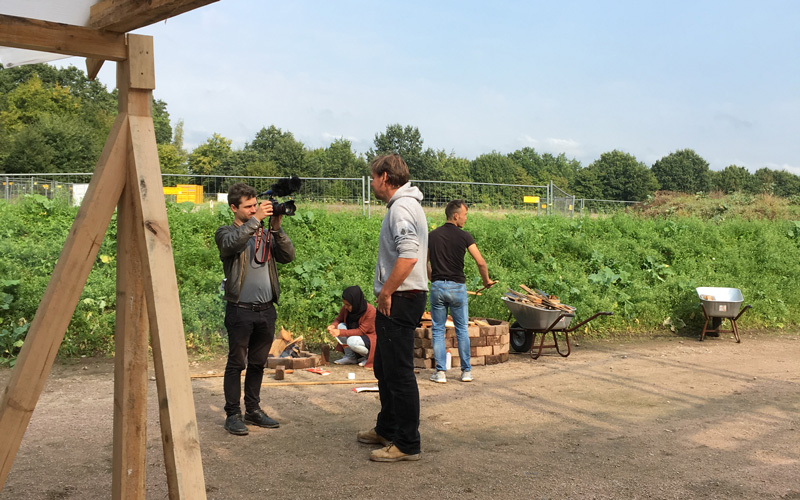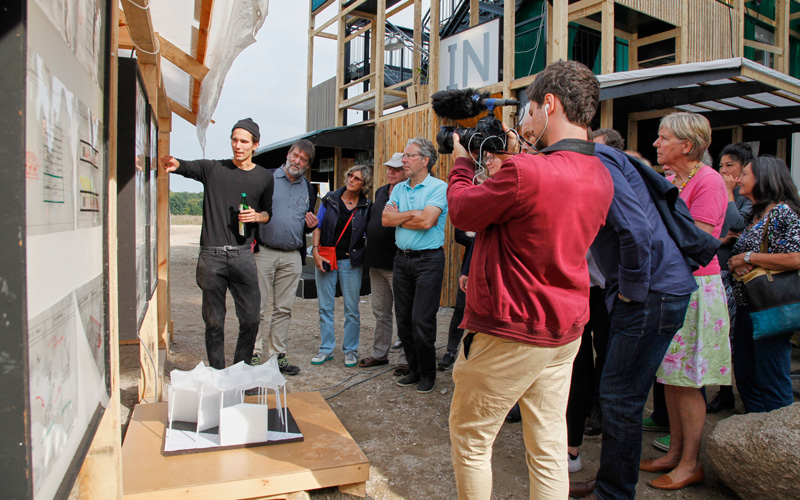



Hi Marko, thank you for stepping in front of the camera. We are here to illustrate your very own procedure of making videos as part of this project archaeology for the project Building a Proposition for Future Activities. We are incredibly happy to collaborate with you on this project.
The idea to do document the project with videos originated in the process leading up to the summer school. There we learned that if the motive of such a project is making new modes of the production of the urban available, the display of issues involved in this motive is of key importance. This led to the collaboration with professional media partners, a graphic designer for all printed matters and it is the reason why we took so much care of the display of the closing day events.
In 2008 Rem Koolhaas said, “when you need perception, you have to generate it yourself and provide an educational model to perceive it”.
Videos are an emerging additional mode of visualisation for urban development projects (Meyer 2016). Real estate companies, architecture and urban planning offices are now more likely to display their future developments in form of a two to three minute video than ever before. Recent architecture exhibitions like the Lisbon Architecture Triennale or the Venice Architecture Biennale have dedicated space to movies putting the process of making buildings in the spotlight, placing the seldom-explored politics of construction site materials, tools and techniques centre stage (see Wainwright 2016).
Lisbon Architecture Triennale curator André Tavares says
“So much discussion in contemporary architecture focuses on participation and the intangible social discourse of design. … We wanted to tackle the act of construction, to show how design affects the organisation of the building site, the impact on labour conditions and the wider, physical realities of making architecture”.
With this in mind, let’s focus on your efforts of making videos as part of the project archaeology Building a Proposition for Future Activities. How do you embed yourself in the project’s motif and its processes in the field?
Marko
There is no shotlist or script, but we did talk about the summer school’s programme in the days leading up to its beginning: who is doing what on site, what is of particular interest, how do things happen …
The shopping for coffee sequence is one of the first videos I made. It shows you and some industrial school students shopping for breakfast, which was scheduled about that time we left for the supermarket. When we stood around in the first morning of the summer school, the perplexity of the situation was hard to miss … To me it appeared as “a […] sort of limbo world” (Ryle 1949, 119 cited in Easterling 2010). I needed to get a hold of some of the action and decided to follow you. I guess you told me that you are going shopping.
After some time in the field I realized that it is the different modes of collaboration that interest me. So, I made my own programme and a “checklist” of people or situations I wanted to shoot. This proved a productive tool to realize some shots. I did interviews with Alexander Römer, Christopher Dell, Maja Momic and others. This was something we did not talk about prior to the summer school, but I came up with on my own.
Dominique
What questions did you ask?
Marko
I asked them about their particular role in the project. I asked Christopher Dell how he does all the archiving, I asked Alexander Römer about his role as the construction manager, Maja Momic about her research and the industrial school students about their motive of participating in the summer school and their experience of the interaction with international students and refugees on site. The goal to open up a situation framed by actions and motives.
In that particular situation I did not know any people before the summer school, and I did not prepare for this, so all I could ask them to begin with was something that gets them talking on their own. For this I do follow a more or less standardised modell of interviewing: I give instructions before hitting the record button like ‘try to talk in brief sentences’ and ask straightforward questions like ‘What is your function here? How do you work, is there a method and how does it work in this concret situation so far?’
The most important thing here is that there are takes. Which means you can do takes over and over again until the meaning is conveied. Often I asked interviewees to repeat what they just said in a slightly different version. I bring up an issue referring to something that happened in the near past or present, like asking Alexander Römer about the support structure right after the 2nd beam came up. This usually keeps people tied to an issue.
Dominique
The projects motive and the upcomging issues function as vectors for its analysis in the form of the project archaeology. How does your process of editing and selecting material look like?
Marko
I guess our goal was to show the project as is, and not some idealized form of it. The scene in the supermarket is rather long, it tackles the viewers in the way that it’s somehow awkward to watch you standing in front of the coffee aisle and select coffee – an action that is familiar to probably all of us.
Documenting should create some kind of transparency in this otherwise multi-layered situation. Of course there are a lot of things going through your head when stand in front of the coffee aisle for minutes and minutes. It is this perplexity and how to deal with it that I wanted show. I figured this is somehow one of the core issues in the summer school, which is some sort of laboratory situation, right?
Dominique
Sure, yeah.
Marko
When editing I try to edit to the classic scheme of opening or entering a situation, finding its focus or motive, and closing with some kind of content. Again, a clear structure is important to make a beginning with the my work. I have all the data organized on a timeline to begin with. In the days after the summer school I started seeing some of the material and editing according to what I figured are videos that make sense. I sent a first package with drafts to you. How did you feel about those?
Dominique
Some of those were actually spot on, others were not yet there. However, this first package of videos gave me an insight of things to come.
Marko
It was only when you came up with the structure for the E-Learning Arrangement that the post-production efforts took off.
Dominique
Right, and your videos played a key role in figuring it out. We did show some videos of your first package in a conference in Liverpool called Housing Critical Futures and another one in Sheffield. This was an important feedback loop to figure out what the structure of the E-Learning arrangement could play out. In the seminar Project Management in Urban Design I presented students with 5 videos to begin the work on a project archaeology. These two examples are part of the many ways your post-production process and our way of doing Urban Design in the research and teaching are intertwined. This mode of collaboration in the production of material proved to be prolific for transposing some of the projects key issues to a next step.
What are the roles of the cameraman?
The cameraman's prime job is to grasp virtualities unfolding in the process of the summer school Building a Proposition for Future Activities. He is not following a script given to him by his recording manager, but improvises along the performativity of unfolding activities. Everything he shoots is relevant. It part of the notation system of the process. To develop the criteria of relevance is the task of project archaeology.
Easterling, Keller., 2010. “The Action is the Form. ” InDérive. Understanding Stadtforschung, (40/41), 29–31.
Meyer, Friederike., 2016. "BAUWELT - Der Film als zusätzliche Visualisierung". Bauwelt, (38), 20–21.
Wainwright, Oliver., 2016. "The secret life of building sites: the show that puts cranes and cement-mixers centre stage". The Guardian, 18 Oct.